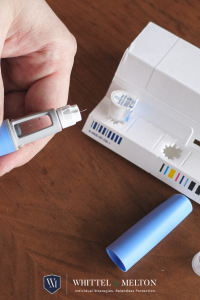Concerns have been raised recently regarding a possible connection between gastroparesis, or stomach paralysis, and Ozempic. When stomach muscles malfunction, the stomach’s contents take longer to pass through the small intestine, a disease known as gastroparesis.
Allegations associate the medication with serious and possibly fatal adverse effects, such as:
- Stomach paralysis (gastroparesis)
- Diarrhea
- Continuous Vomiting
- Persistent Nausea
Our committed dangerous drug legal experts at Whittel & Melton are available to evaluate your case and help you every step of the way. Contact us now or call 866-608-5529 to learn more.
How Are Semaglutide Medications Supposed To Work?
 Ozempic and Wegovy, both made by Novo Nordisk, are injectable medications containing semaglutide, belonging to a class of drugs known as GLP-1 receptor agonists. It works by stimulating insulin production in response to elevated blood sugar levels, thereby regulating glucose levels in patients with type 2 diabetes. These medications copy the GLP-1 hormone in our bodies using semaglutide. This hormone helps prolong feelings of fullness by slowing down the rate at which our stomachs empty. However, recent studies and patient reports have suggested a potential correlation between Ozempic and Wegovy use and the onset of gastroparesis, ileus, and intestinal blockage.
Ozempic and Wegovy, both made by Novo Nordisk, are injectable medications containing semaglutide, belonging to a class of drugs known as GLP-1 receptor agonists. It works by stimulating insulin production in response to elevated blood sugar levels, thereby regulating glucose levels in patients with type 2 diabetes. These medications copy the GLP-1 hormone in our bodies using semaglutide. This hormone helps prolong feelings of fullness by slowing down the rate at which our stomachs empty. However, recent studies and patient reports have suggested a potential correlation between Ozempic and Wegovy use and the onset of gastroparesis, ileus, and intestinal blockage.
What is Gastroparesis?
The illness known as gastroparesis is characterized by a delayed stomach emptying, which can cause symptoms like bloating, nausea, vomiting, abdominal discomfort, and unstable blood sugar levels. Studies have linked Ozempic use and the development of gastroparesis.
What is Ileus?
Ileus is another gastrointestinal disorder characterized by a lack of movement in the intestines, resulting in a blockage or obstruction. This can lead to symptoms such as severe abdominal pain, distension, constipation, and vomiting. Like gastroparesis, ileus can be caused by various factors, including medication use. In the case of Ozempic, studies have suggested a potential link between the drug and the development of ileus.
What is Intestinal Blockage?
Intestinal blockage or obstruction refers to a complete or partial blockage of the intestines, which can prevent the passage of food, fluids, and gas. This serious condition requires immediate medical attention and may necessitate surgery to resolve. There have been reports of intestinal blockage associated with the use of Ozempic.
What Do These Lawsuits Allege?
Legal actions have been brought against Novo Nordisk because of certain Ozempic users reporting symptoms suggesting gastroparesis. Plaintiffs in these cases allege that the medicine contributed to the development of stomach paralysis and that its makers failed to appropriately notify them and healthcare providers about this potential risk.
Until recently, Ozempic’s warning label failed to adequately inform healthcare professionals and patients about the danger of these potential issues. Anyone who developed gastroparesis after taking Ozempic may be entitled to financial compensation for their injuries by pursuing a product liability claim.
As of February 2024, there are cases involving Ozempic, Rybelsus, Wegovy, Trulicity, and Mounjaro that are classified as MDL class action litigation.
Should you have developed gastroparesis from any of these drugs, our Ozempic lawyers at Whittel & Melton can help. Call us now at 866-608-5529 or contact us online for a free consultation.
Key Ozempic MDL Timeline:
As of May 2024, MDL 3094 in the Eastern District of Pennsylvania contained 87 personal injury lawsuits alleging gastroparesis, ileus, and intestinal blockage or obstruction.
May 2024: On May 17, Judge Gene E. K. Pratter, who was presiding over the Ozempic MDL, passed away suddenly in Philadelphia. As the Judicial Panel on Multidistrict Litigation deliberated over how to reassign the MDL, experts expect case delays.
March 2024: The litigation process was still in its early stages. Novo Nordisk and Eli Lilly filed notices of appearance. More plaintiffs move into the MDL.
February 2024: A federal multidistrict litigation in the Eastern District of Pennsylvania consolidated at least fifty-five cases alleging serious gastrointestinal ailments were caused by Ozempic and other GLP-1 receptor agonist class medications. Attorneys for the plaintiffs predicted that the figure may rise above 10,000.
January 2024: According to the FDA, it was reviewing reports of hair loss, suicidal thoughts, and aspiration while under sedation or anesthesia in patients using Ozempic and related weight loss and diabetic drugs. The action was taken in response to numerous reports of potential adverse effects that were entered into the FDA Adverse Event Reporting System database.
September 2023: FDA updated the warning label for Ozempic to include ileus and intestinal blockage/obstruction.
August 2023: The first Ozempic gastroparesis lawsuit was filed. Continue reading













